Viscoelasticity of PPA/SBS/SBR Composite Modified Asphalt and Asphalt Mixtures Under Pressure Aging Conditions
Abstract
:1. Introduction
2. Materials and Methods
2.1. Aging Tests
2.1.1. RTFOT Test
2.1.2. PAV Test
2.2. Asphalt and Asphalt Mixture
2.2.1. Asphalt
2.2.2. Asphalt Mixture
Asphalt Mixture Design and Forming
Asphalt Mixture Viscoelasticity Test
2.3. Dynamic Shear Rheometer (DSR) Test
2.4. Structural Characterization
2.4.1. FTIR Test
2.4.2. GPC Test
3. Results
3.1. Test Results of Asphalt Rheological Properties
3.2. FTIR Analysis
3.3. GPC Analysis
3.4. High and Low Temperature Performance of Asphalt Mixture
3.4.1. Marshall Test
3.4.2. Analysis of Road Performance
3.5. Viscoelasticity
4. Conclusions
Author Contributions
Funding
Institutional Review Board Statement
Data Availability Statement
Conflicts of Interest
References
- Chen, H.; Saba, R.G.; Liu, G.; Barbieri, D.M.; Zhang, X.; Hoff, I. Influence of material factors on the determination of dynamic moduli and associated prediction models for different types of asphalt mixtures. Constr. Build. Mater. 2023, 365, 130134. [Google Scholar] [CrossRef]
- Xiang, L.; Cheng, J.; Kang, S. Thermal oxidative aging mechanism of crumb rubber/SBS composite modified asphalt. Constr. Build. Mater. 2015, 75, 169–175. [Google Scholar] [CrossRef]
- Lee, S.-J.; Amirkhanian, S.N.; Shatanawi, K.; Kim, K.W. Short-term aging characterization of asphalt binders using gel permeation chromatography and selected Superpave binder tests. Constr. Build. Mater. 2008, 22, 2220–2227. [Google Scholar] [CrossRef]
- Zhang, H.; Chen, Z.; Xu, G.; Shi, C. Physical, rheological and chemical characterization of aging behaviors of thermochromic asphalt binder. Fuel 2018, 211, 850–858. [Google Scholar] [CrossRef]
- Yao, X.; Wang, Y.; Xu, T. Development on recycling, aging simulation and regeneration methods of reclaimed styrene-butadiene-styrene modified asphalt. J. Clean. Prod. 2021, 312, 127767. [Google Scholar] [CrossRef]
- Zhang, J.; Guo, N.; Cui, S.; Chu, Z.; You, Z.; Tan, Y. Preparation and performance analysis of polyamide-based rapid repair material for asphalt pavement shallow groove. Constr. Build. Mater. 2024, 419, 14. [Google Scholar] [CrossRef]
- Menapace, I.; Masad, E. Evolution of the microstructure of unmodified and polymer modified asphalt binders with aging in an accelerated weathering tester. J. Microsc. 2016, 263, 341–356. [Google Scholar] [CrossRef]
- Liu, Y.; Xu, X.; Huang, Z.; Zhao, M. Discrete-continuous coupling simulation and analysis for asphalt pavement dynamic stress responses under a moving wheel load. Case Stud. Constr. Mater. 2023, 18, e01932. [Google Scholar] [CrossRef]
- Xu, S.; Tang, G.; Pan, S.; Ji, Z.; Fang, L.; Zhang, C.; Cao, Z.; Zhou, X.; Jia, X. Application of reactive rejuvenator in aged SBS modified asphalt regeneration: A review. Constr. Build. Mater. 2024, 421, 17. [Google Scholar] [CrossRef]
- Han, D.; Hu, G.; Zhang, J. Study on Anti-Aging Performance Enhancement of Polymer Modified Asphalt with High Linear SBS Content. Polymers 2023, 15, 526. [Google Scholar] [CrossRef]
- Xiao, X.; Wang, J.; Wang, T.; Amirkhanian, S.N.; Xiao, F. Linear viscoelasticity of asphalt in view of proportion and polarity of SARA fractions. Fuel 2024, 363, 130955. [Google Scholar] [CrossRef]
- Yu, Z.; Ban, X.; Xu, Y.; Liu, X.; Ma, L.; Liu, S.; Zhang, Z.; Zhou, Y. Study on the Rheological Performance and Microscopic Mechanism of PPA/SBS/SBR Composite-Modified Asphalt Cold Replenishment Liquid. Appl. Sci. 2023, 13, 11193. [Google Scholar] [CrossRef]
- Ruan, Y.; Davison, R.R.; Glover, C.J. The effect of long-term oxidation on the rheological properties of polymer modified asphalts. Fuel 2003, 82, 1763–1773. [Google Scholar] [CrossRef]
- Wu, S.; Pang, L.; Liu, G.; Zhu, J. Laboratory study on ultraviolet radiation aging of bitumen. J. Mater. Civil Eng. 2010, 22, 767–772. [Google Scholar] [CrossRef]
- Chen, Z.; Zhang, H.; Shi, C.; Wei, C. Rheological performance investigation and sustainability evaluation of asphalt binder with thermochromic powders under solar radiation. Sol. Energy Mater. Sol. Cells 2019, 191, 175–182. [Google Scholar] [CrossRef]
- Zhang, Z.; Wang, S.; Lu, G. Properties of new cold patch asphalt liquid and mixture modified with waterborne epoxy resin. Int. J. Pavement Eng. 2020, 21, 1606–1616. [Google Scholar] [CrossRef]
- Liu, M.; Han, S.; Han, X.; Qi, X.; Dong, S. Microcapsule and polymer reinforcement techniques developed asphalt for use of pothole repairs in winter and rainy seasons. Cold Reg. Sci. Technol. 2019, 167, 102865. [Google Scholar] [CrossRef]
- Liu, M.; Han, S.; Shang, W.; Qi, X.; Dong, S.; Zhang, Z. New polyurethane modified coating for maintenance of asphalt pavement potholes in winter-rainy condition. Prog. Org. Coat. 2019, 133, 368–375. [Google Scholar] [CrossRef]
- Ma, F.; Li, C.; Fu, Z.; Huang, Y.; Dai, J.; Feng, Q. Evaluation of high temperature rheological performance of polyphosphoric acid-sbs and polyphosphoric acid-crumb rubber modified asphalt. Constr. Build. Mater. 2021, 306, 124926. [Google Scholar] [CrossRef]
- Yang, X.; Peng, C.; Chen, J.; Liu, G.; He, X. Effect of short-term aging on rheological properties of bio-asphalt/sbs/ppa composite modified asphalt. Case Stud. Constr. Mater. 2023, 19, e02439. [Google Scholar] [CrossRef]
- Li, C.; Li, Z.; Guo, T.; Chen, Y.; Liu, Q.; Wang, J.; Jin, L. Study on the Performance of SBS/Polyphosphoric Acid Composite Modified Asphalt. Coatings 2024, 14, 72. [Google Scholar] [CrossRef]
- Zhang, F.; Li, L. Effect mechanism of acidification and vulcanization on sbs-modified asphalt. Int. Polym. Process. 2022, 37, 559–567. [Google Scholar] [CrossRef]
- Wei, J.; Shi, S.; Zhou, Y.; Chen, Z.; Yu, F.; Peng, Z.; Duan, X. Research on Performance of SBS-PPA and SBR-PPA Compound Modified Asphalts. Materials 2022, 15, 2112. [Google Scholar] [CrossRef] [PubMed]
- Guo, M.; Yin, X.; Du, X.; Tan, Y. Effect of Aging, Testing Temperature and Relative Humidity on Adhesion between Asphalt Binder and Mineral Aggregate. Constr. Build. Mater. 2023, 363, 16. [Google Scholar] [CrossRef]
- Yang, B.; Li, H.; Xie, N.; Yang, J.; Liu, J. Surface Characteristics of Ageing Asphalt Binder Coupling Thermal Oxidation and Ultraviolet Radiation. Transp. Res. Rec. 2022, 2676, 147–162. [Google Scholar] [CrossRef]
- Yang, B.; Li, H.; Zhang, H.; Xie, N.; Zhou, H. Laboratorial investigation on effects of microscopic void characteristics on properties of porous asphalt mixture. Constr. Build. Mater. 2019, 213, 434–446. [Google Scholar] [CrossRef]
- Remisova, E.; Briliak, D. Evaluation of the Effect of Thermo-Oxidative Aging and UV Radiation on Asphalt Stiffness. Materials 2023, 16, 3716. [Google Scholar] [CrossRef]
- Zhao, Z.; Xu, L.; Du, Z.; Xiao, F. Moisture resistance of stone matrix asphalt at lab simulated high temperature and continuous rainfall condition. Int. J. Pavement Eng. 2022, 24, 2096884. [Google Scholar] [CrossRef]
- Feng, B.; Wang, H.; Li, S.; Ji, K.; Li, L.; Xiong, R. The durability of asphalt mixture with the action of salt erosion: A review. Constr. Build. Mater. 2022, 315, 125749. [Google Scholar] [CrossRef]
- Zhang, K.; Li, W.; Han, F. Performance deterioration mechanism and improvement techniques of asphalt mixture in salty and humid environment. Constr. Build. Mater. 2019, 208, 749–757. [Google Scholar] [CrossRef]
- Jahanbakhsh, H.; Karimi, M.M.; Naseri, H.; Nejad, F.M. Sustainable asphalt concrete containing high reclaimed asphalt pavements and recycling agents: Performance assessment, cost analysis, and environmental impact. J. Clean. Prod. 2020, 244, 118837. [Google Scholar] [CrossRef]
- Jattak, Z.A.; Hassan, N.; Satar, M. Moisture Susceptibility and Environmental Impact of Warm Mix Asphalt Containing Bottom Ash. Case Stud. Constr. Mater. 2021, 15, e00636. [Google Scholar] [CrossRef]
- Ling, M.; Luo, X.; Gu, F.; Lytton, R.L. Time-temperature-aging-depth shift functions for dynamic modulus master curves of asphalt mixtures. Constr. Build. Mater. 2017, 157, 943–951. [Google Scholar] [CrossRef]
- Zhang, S.; Zhang, H.; Zhou, M. Investigation on the high-temperature stability and fatigue behavior of cold mixed epoxy asphalt mixture with different gradations. Case Stud. Constr. Mater. 2024, 20, e02694. [Google Scholar] [CrossRef]
- Sirin, O.; Paul, D.K.; Khan, M.S.; Kassem, E.; Darabi, M.K. Effect of Aging on Viscoelastic Properties of Asphalt Mixtures. J. Transp. Eng. Part B Pavements 2019, 145, 04019034. [Google Scholar] [CrossRef]
- Al-Tawalbeh, A.; Sirin, O.; Sadeq, M.; Sebaaly, H.; Masad, E. Evaluation and calibration of dynamic modulus prediction models of asphalt mixtures for hot climates: Qatar as a case study. Case Stud. Constr. Mater. 2022, 17, e01580. [Google Scholar] [CrossRef]
- Nobakht, M.; Sakhaeifar, M.S. Dynamic modulus and phase angle prediction of laboratory aged asphalt mixtures. Constr. Build. Mater. 2018, 190, 740–751. [Google Scholar] [CrossRef]
- Sadeghi, P.; Karimi, A.; Torbatifard, S.; Goli, A. A comprehensive evaluation of damping, vibration, and dynamic modulus in reclaimed asphalt pavement: The role of rejuvenators, polymer, temperature, and aging. Case Stud. Constr. Mater. 2024, 21, e03366. [Google Scholar] [CrossRef]
- Ji, Y.; Cao, L.; Li, Z.; Chen, G.; Cao, P.; Liu, T. Numerical Conversion Method for the Dynamic Storage Modulus and Relaxation Modulus of Hydroxy-Terminated Polybutadiene (HTPB) Propellants. Polymers 2022, 15, 3. [Google Scholar] [CrossRef]
- Bhattacharjee, S.; Swamy, A.K.; Daniel, J.S. Continuous relaxation and retardation spectrum method for viscoelastic characterization of asphalt concrete. Mech. Time-Depend. Mater. 2012, 16, 287–305. [Google Scholar] [CrossRef]
- Forough, S.A.; Nejad, F.M.; Khodaii, A. Comparison of tensile and compressive relaxation modulus of asphalt mixes under various testing conditions. Mater. Struct. 2016, 49, 207–223. [Google Scholar] [CrossRef]
- Liu, H.; Li, Y.; Fan, G.; Yuan, J.; Lu, W.; Xu, Q.; Jiang, S. Uniform moduli characterization of asphalt mixtures under dynamic and static loading conditions. Case Stud. Constr. Mater. 2023, 19, e02527. [Google Scholar] [CrossRef]
- Jwaida, Z.; Dulaimi, A.; Mydin, A.O.; Özkılıç, Y.O.; Jaya, R.P.; Ameen, A. The Use of Waste Polymers in Asphalt Mixtures: Bibliometric Analysis and Systematic Review. J. Compos. Sci. 2023, 7, 415. [Google Scholar] [CrossRef]
- Zhang, H.; Yu, J.; Feng, Z.; Xue, L.; Wu, S. Effect of aging on the morphology of bitumen by atomic force microscopy. J. Microsc. Oxford. 2012, 246, 11–19. [Google Scholar] [CrossRef]
- Zhao, Z.; Xiao, F.; Toraldo, E.; Crispino, M.; Ketabdari, M. Effect of Crumb Rubber and Reclaimed Asphalt Pavement on Viscoelastic Property of Asphalt Mixture. J. Clean. Prod. 2023, 428, 139422. [Google Scholar] [CrossRef]
- Ding, H.; Hesp, S.A.M. Variable-temperature Fourier-transform infrared spectroscopy study of asphalt binders from the SHRP Materials Reference Library. Fuel 2021, 298, 120819. [Google Scholar] [CrossRef]
- JTG 3432-2024; Test Regulations for Aggregates in Highway Engineering. People’s Communications Press Co., Ltd.: Beijing, China, 2024.
- JTG F40-2004; Technical Specification for Construction of Highway Asphalt Pavements. People’s Communications Press: Beijing, China, 2024.
- Zhao, Z.; Wang, J.; Hou, X.; Xiang, Q.; Xiao, F. Viscosity Prediction of Rubberized Asphalt–Rejuvenated Recycled Asphalt Pavement Binders Using Artificial Neural Network Approach. J. Mater. Civ. Eng. 2021, 33, 04021071. [Google Scholar] [CrossRef]
- Zhang, H.; Xu, G.; Zhu, C. Effects of long-term aging on chemical composition, morphology and rheological properties of matrix asphalt and SBS modified asphalt. J. Chang’an Univ. Nat. Sci. Ed. 2019, 39, 10–56. (In Chinese) [Google Scholar]
- Wang, H.; Liu, X.; Apostolidis, P.; van de Ven, M.; Erkens, S.; Skarpas, A. Effect of laboratory aging on chemistry and rheology of crumb rubber modified bitumen. Mater. Struct. 2020, 53, 26. [Google Scholar] [CrossRef]
- Petersen, J.C. A Review of the Fundamentals of Asphalt Oxidation: Chemical, Physicochemical, Physical Property, and Durability Relationships; Transportation Research Board: Washington, DC, USA, 2009. [Google Scholar]
- Zhao, Y.; Gu, F.; Xu, J.; Jin, J. Analysis of aging mechanism of SBS polymer modified asphalt based on Fourier transform infrared spectrum. J. Wuhan Univ. Technol. 2010, 25, 1047–1052. [Google Scholar] [CrossRef]
- Wang, P.; Zhai, F.; Dong, Z.J.; Wang, L.Z.; Liao, J.P.; Li, G.R. Micromorphology of Asphalt Modified by Polymer and Carbon Nanotubes through Molecular Dynamics Simulation and Experiments: Role of Strengthened Interfacial Interactions. Energy Fuels 2018, 32, 1179–1187. [Google Scholar] [CrossRef]
- Wang, R.; Yue, M.; Xiong, Y.; Yue, J. Experimental study on mechanism, aging, rheology and fatigue performance of carbon nanomaterial/SBS-modified asphalt binders. Constr. Build. Mater. 2020, 268, 121189. [Google Scholar] [CrossRef]
- Shen, J.; Amirkhanian, S.N.; Lee, S.-J. HP-GPC Characterization of Rejuvenated Aged CRM Binders. J. Mater. Civ. Eng. 2007, 19, 515–522. [Google Scholar] [CrossRef]
- Xu, S.; Huang, R.; Fang, L.; Zhou, X.; Cao, Z.; Zhang, C.; Ma, H.; Ji, Z. Novel rejuvenators for sustainable recycling of aged SBS modified bitumen: Performance evaluation and reactive mechanism analysis. J. Clean. Prod. 2024, 434, 140147. [Google Scholar] [CrossRef]
- Ma, J.; Sun, G.; Sun, D.; Yu, F.; Hu, M.; Lu, T. Application of gel permeation chromatography technology in asphalt materials: A review. Constr. Build. Mater. 2021, 278, 122386. [Google Scholar] [CrossRef]
- JTG E20-2011; Test Code for Asphalt and Asphalt Mixture in Highway Engineering. People’s Communications Press: Beijing, China, 2011.

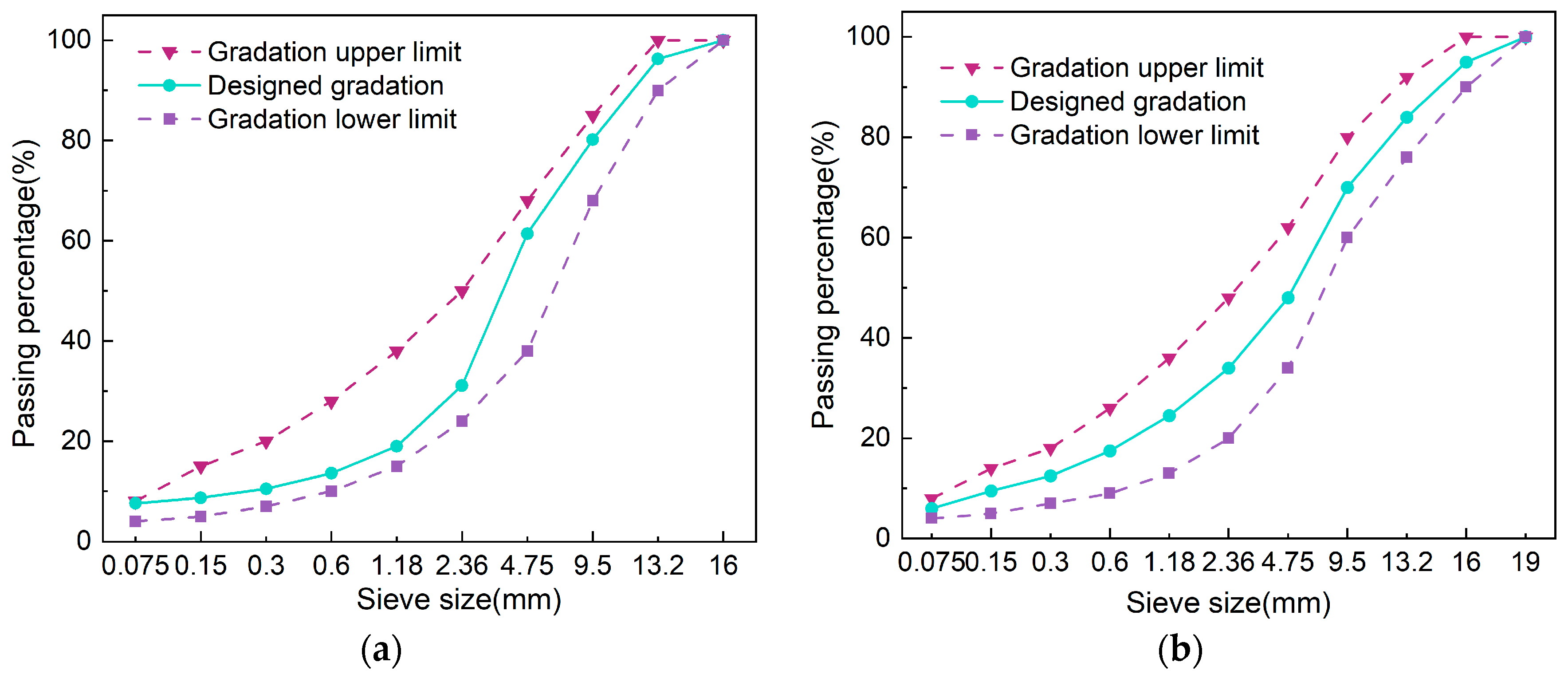

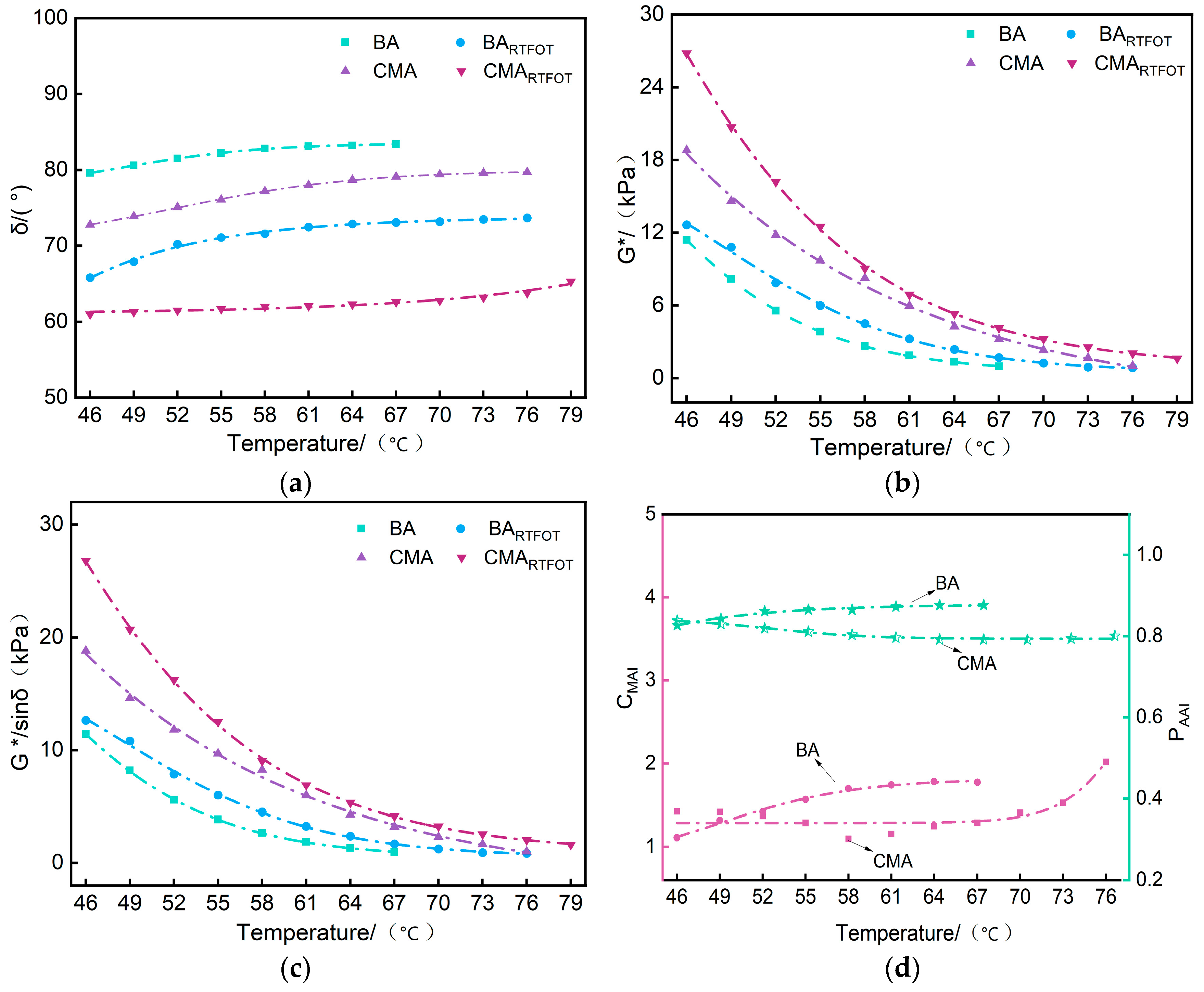
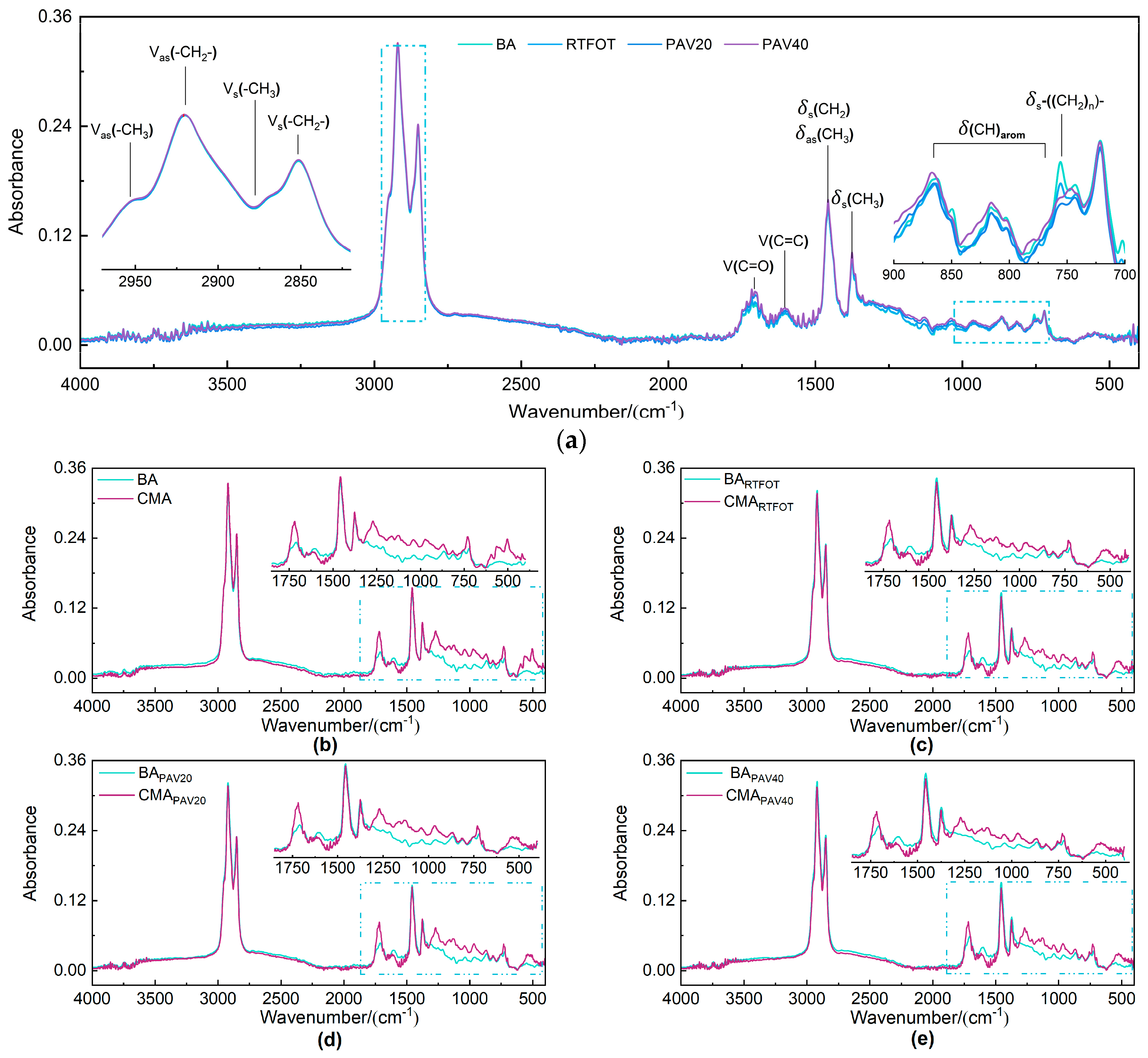





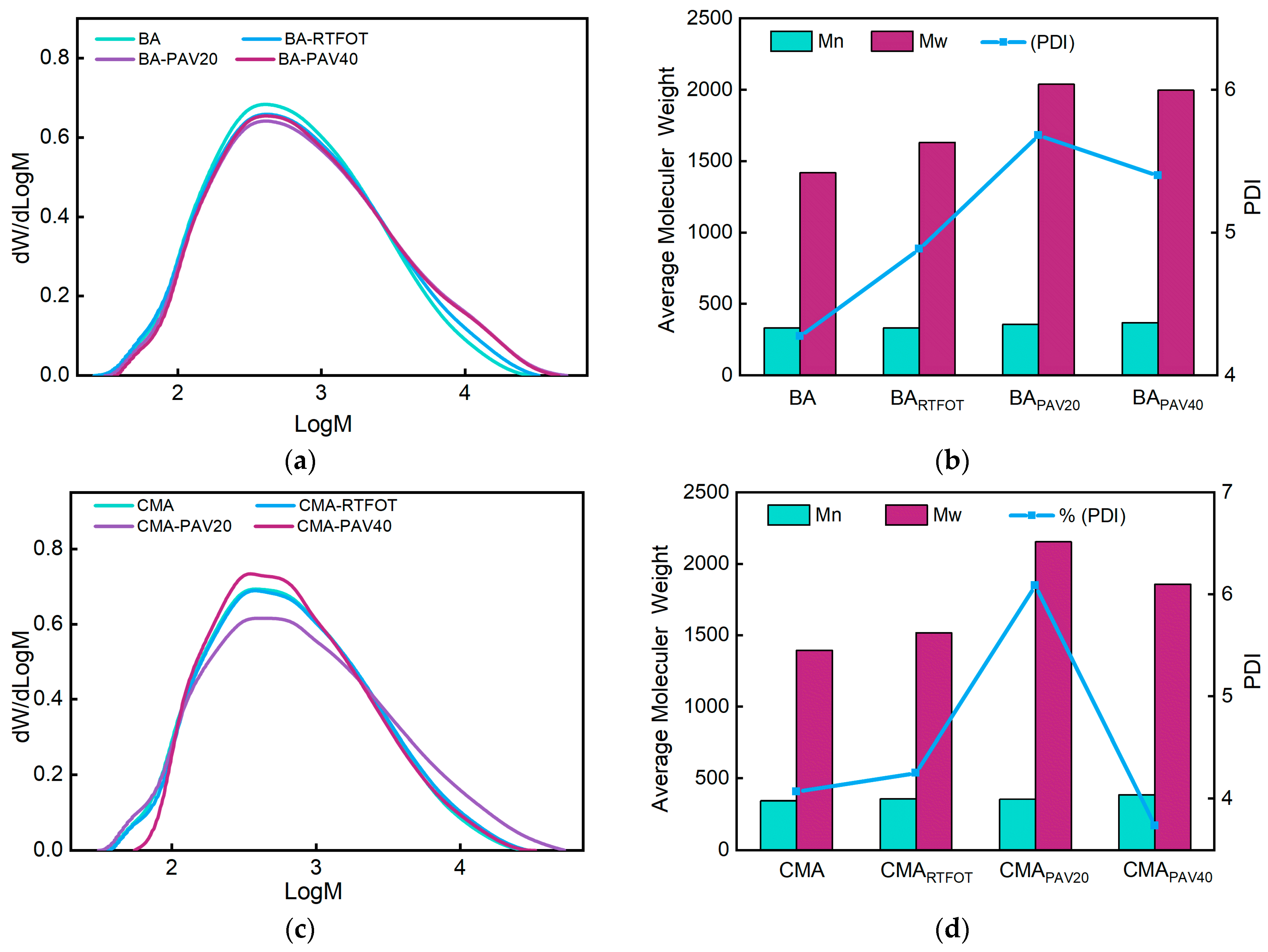





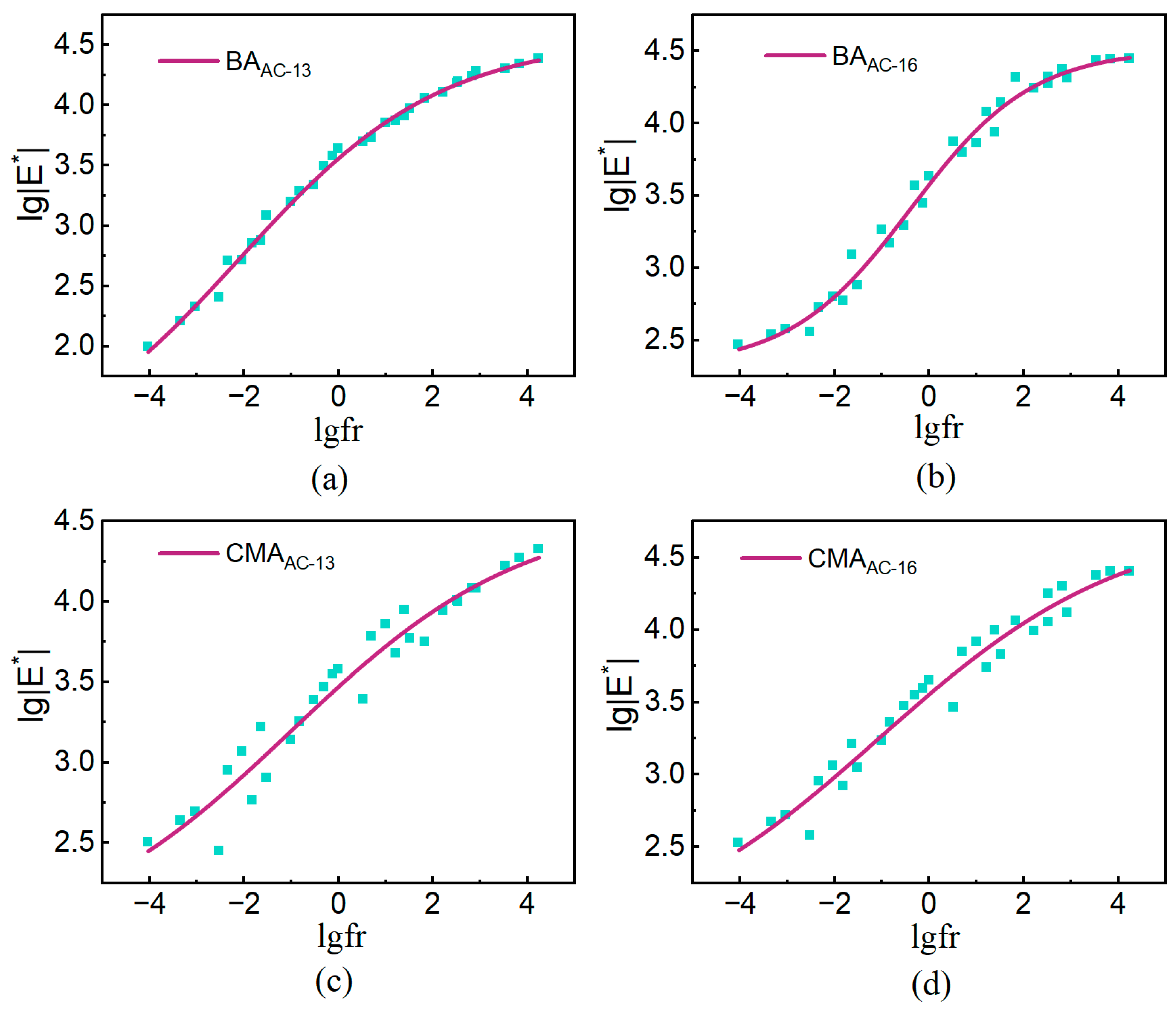
| Detecting Parameter | Apparent Relative Density | Relative Density of Gross Volume | Water Absorption (%) | Detection Result |
|---|---|---|---|---|
| Sample Name | ||||
| Gravel (15–20) mm | 2.871 | 2.842 | 0.28 | Qualified |
| Gravel (10–15) mm | 2.862 | 2.827 | 0.43 | |
| Gravel (5–10) mm | 2.855 | 2.803 | 0.64 | |
| Gravel (3–5) mm | 2.849 | 2.794 | 0.69 | |
| Machine sand (0–3) mm | 2.821 | 2.755 | / | |
| Mineral powder | 2.718 | / | / | |
| Technical requirements | Gravel ≮ 2.60 | / | ≯2.0 | / |
| Machine sand ≮ 2.50 |
| Limestone | Property | Unit | Tested Values | Code Values |
|---|---|---|---|---|
| Mineral powder | Apparent density(kg·m−3) | g/cm3 | 2.718 | ≥2.50 |
| Water carrying capacity (%) | % | 0.104 | ≤1 | |
| Passing percentage (%) | 0.6 mm | 100 | 100 | |
| <0.15 mm | 98.1 | 90~100 | ||
| <0.075 mm | 87.2 | 75~100 | ||
| Appearance | / | No agglomerates | No agglomerates | |
| Hydrophilic coefficient | / | 0.4 | <1 | |
| Plasticity index (%) | % | 2.56 | <4 |
Disclaimer/Publisher’s Note: The statements, opinions and data contained in all publications are solely those of the individual author(s) and contributor(s) and not of MDPI and/or the editor(s). MDPI and/or the editor(s) disclaim responsibility for any injury to people or property resulting from any ideas, methods, instructions or products referred to in the content. |
© 2025 by the authors. Licensee MDPI, Basel, Switzerland. This article is an open access article distributed under the terms and conditions of the Creative Commons Attribution (CC BY) license (https://creativecommons.org/licenses/by/4.0/).
Share and Cite
Yu, Z.; Ling, X.; Fan, Z.; Zhou, Y.; Ma, Z. Viscoelasticity of PPA/SBS/SBR Composite Modified Asphalt and Asphalt Mixtures Under Pressure Aging Conditions. Polymers 2025, 17, 698. https://doi.org/10.3390/polym17050698
Yu Z, Ling X, Fan Z, Zhou Y, Ma Z. Viscoelasticity of PPA/SBS/SBR Composite Modified Asphalt and Asphalt Mixtures Under Pressure Aging Conditions. Polymers. 2025; 17(5):698. https://doi.org/10.3390/polym17050698
Chicago/Turabian StyleYu, Zongjie, Xinpeng Ling, Ze Fan, Yueming Zhou, and Zhu Ma. 2025. "Viscoelasticity of PPA/SBS/SBR Composite Modified Asphalt and Asphalt Mixtures Under Pressure Aging Conditions" Polymers 17, no. 5: 698. https://doi.org/10.3390/polym17050698
APA StyleYu, Z., Ling, X., Fan, Z., Zhou, Y., & Ma, Z. (2025). Viscoelasticity of PPA/SBS/SBR Composite Modified Asphalt and Asphalt Mixtures Under Pressure Aging Conditions. Polymers, 17(5), 698. https://doi.org/10.3390/polym17050698







